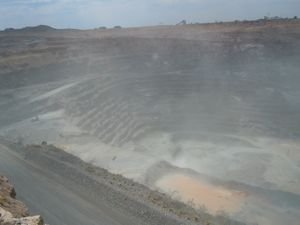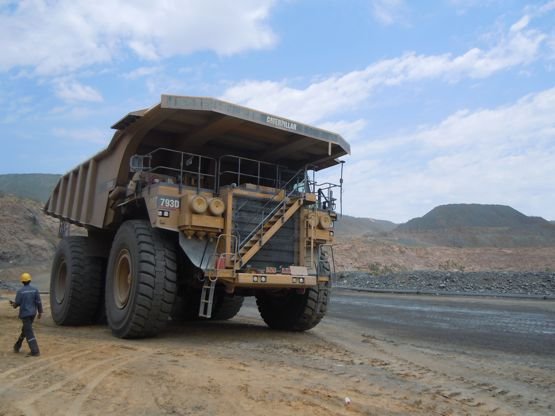After our tour yesterday of the Jwaneng diamond mine I find myself doubly baffled by this week’s effort by a worldwide tribal-rights group to organize a boycott of Botswana diamonds.
First of all, we learned on the tour that it is impossible to tell at retail which diamonds come from Botswana. The Jwaneng mine, which is the richest diamond mine in the world by value, sends its diamonds for sorting in Gaborone and then on to major diamond centers for cutting and polishing. In this process, diamonds from all over the world are commingled, making identification by country impossible.
Secondly, everything we’ve heard since arriving in Botswana has underscored the nation’s success in developing its diamond resources in a way that benefits the nation’s 2 million people in thoroughgoing ways. The Jwaneng mine is owned by Debswana Diamond Company, a 50-50 partnership between the Government of Botswana and De Beers. Our guide at the mine, Diane Moseki, stated that 30 percent of the nation’s gross domestic product and half of the government’s revenue come from the diamond industry. That revenue has been used to develop roads, water supplies, electricity, telecommunications, health facilities, and schools. In the fewer than 40 years since diamond mining commenced here, Botswana has become the world’s leading diamond producer.
The rights group three days ago organized protests at which supporters held signs saying “Save the Bushmen” and “Boycott Botswana Diamonds.” At issue is how the government is treating approximately 1,000 Bushmen moved eight years ago from an area in the Kalahari Game Reserve that is now being targeted for a new diamond mine, unrelated to Debswana.
 Kitso Mokaila, Botswana’s minister of environment, wildlife, and tourism, told the BBC this week that the rights group “is on a fund-raising campaign at the expense of a whole people.” He said that painfully slow talks are proceeding, designed to resolve issues related to the moving of the Bushmen. The talks are being mediated by the Botswana Centre for Human Rights and other non-government organizations.
Kitso Mokaila, Botswana’s minister of environment, wildlife, and tourism, told the BBC this week that the rights group “is on a fund-raising campaign at the expense of a whole people.” He said that painfully slow talks are proceeding, designed to resolve issues related to the moving of the Bushmen. The talks are being mediated by the Botswana Centre for Human Rights and other non-government organizations.
After four days in Botswana and one mine tour, I don’t profess to be an expert on tradeoffs between the rights of the Bushmen and the general welfare of the people of Bostwana. But it was difficult yesterday not to be impressed with the pride that Ms. Moseki and Technical Engineer Bokang Motlhagodi displayed in the mine during the tour. The scale of the mine was truly daunting — a pit 380 meters deep, where 240-ton trucks were hauling waste material and ore. The mine’s full-time employees number 2,079 including teachers at the local school and workers in the hospital.
But what of the bushmen? I have not met any, of course, except in the pages of a very good police procedural that I’m reading. Set in Botswana, it is titled A Carrion Death by Michael Stanley ( click here for Kindle version.) A Bushman head man named Tchixo in one scene says of an elder named Gobiwasi: “Sometimes he walks already with his ancestors.” The book’s protagonist, Detective Kubu, bows his head respectfully, appreciating the head man’s elegant reference to Gobiwasi’s occasionally wandering mind. “He was always impressed by the respect these people showed to each other,” the book’s omniscient narrator recounts. “Mutual support was essential for survival.”
As I delve into the story of the Bushmen, I am consulting a real-life author who, we are told, is a favorite of the fictional detective. La urens van der Post (1906-1996) was a passionate chronicler and defender of the Bushmen, and I’ve purchased his best-known book, The Lost World of the Kalahari, for reading on my Kindle.
urens van der Post (1906-1996) was a passionate chronicler and defender of the Bushmen, and I’ve purchased his best-known book, The Lost World of the Kalahari, for reading on my Kindle.
As an alternate view of the Bushmen, I’m struck by this quote from Botswana’s environmental minister, Mr. Mokaila, as reported by the BBC: “I don’t believe you would want to see your own kind living in the dark ages in the middle of nowhere as a choice, when you know that the world has moved forward and has become so technological. We do not want to leave any of our people behind yet in the same breath we do not want any of our people to lose their culture.”
In just a few days we’ve developed an appreciation for Botswana’s contrasts and conflicts. On our two-hour drive to the edge of the Kalahari yesterday, we passed a cart drawn by a six-mule team, free-range cattle, and baboons. At Jwaneng, I sat in the cab of one of the immense hauling trucks, and we posed by wheels bigger than any of us. I noticed a motto of the mine displayed in numerous places, reading “We Make Botswana Sparkle.” That’s the plan, and so far it mainly seems to be working.
 Send to Kindle
Send to Kindle


